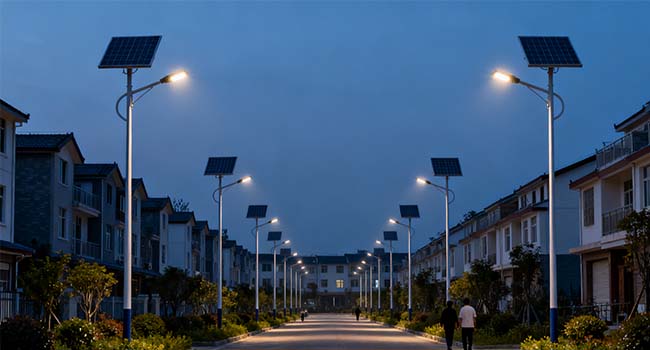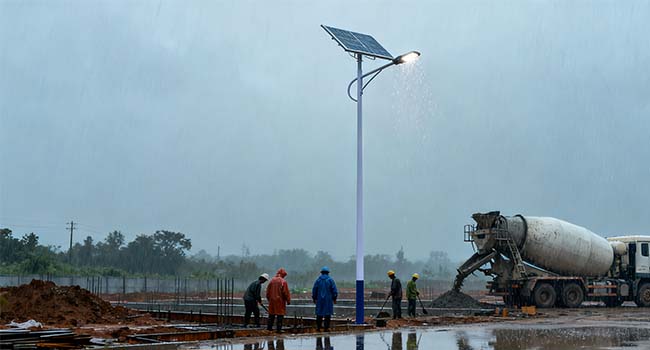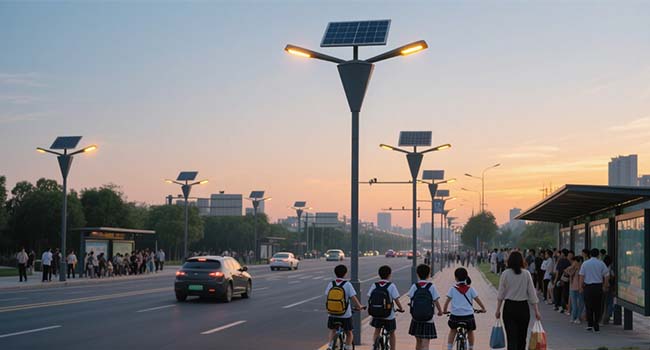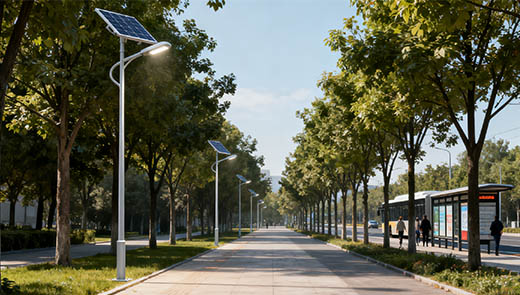Economics of Solar Street Lighting for Construction Projects
Lighting is an indispensable component of construction projects, directly impacting construction safety, progress efficiency, and overall operational costs. Historically, traditional grid-connected street lights dominated as the mainstream choice. However, the cumulative energy consumption expenses and maintenance costs have gradually become a burden for project managers. With the maturation of solar technology and heightened cost control awareness, solar street lights have emerged as a “cost-optimization tool” for the construction industry. This article delves into the economic rationale of solar street lighting in construction projects—from initial investment to long-term returns, from hidden savings to policy incentives—comprehensively analyzing why it represents the economically optimal choice.

Initial Investment in Solar Street Lighting for Construction Projects
Closer Investment Loop
Upfront expenditures are concentrated in two core areas: equipment procurement and installation/construction, forming a “bundled” closed-loop investment. Equipment procurement covers all core functional components including luminaires, solar panels, energy storage batteries, and light poles. Installation services encompass the entire process from foundation pouring to assembly and commissioning. This eliminates the need for additional budgets for basic infrastructure like wiring or ancillary equipment. Precise calculation of initial funding requirements prevents hidden expenditures that could lead to budget overruns, ensuring clearer, more controllable financial planning and facilitating overall project financial coordination and cost management.
Compared to Hidden Costs of Traditional Street Lights
While traditional street light equipment may appear inexpensive at first glance, this price typically covers only the luminaire itself, excluding the complete supporting infrastructure required for normal operation. Subsequent significant investments are required for supporting equipment like cables, transformers, and distribution boxes, along with large-scale construction work such as trench excavation and cable laying. Material and labor costs for these phases often exceed expectations. Additionally, unexpected challenges during construction—such as complex site conditions or increased cable-laying difficulty—can further inflate expenses. Consequently, the overall upfront costs of traditional street lights are frequently underestimated, ultimately leading to steep budget pressures.

Solar Street Light Procurement
The procurement cost of solar street lights is primarily determined by core components: the luminaire (including LED light source), solar panels, energy storage batteries, light poles, and control systems. The quality and functionality of these components directly influence both the purchase price and subsequent operational costs.
Price Comparison
While the unit purchase price of standard solar street lights is indeed higher than traditional high-pressure sodium lamps, the “low cost” of conventional lights refers solely to the equipment itself. Additional expenses for transformers, cables, distribution boxes, and other ancillary equipment must be factored in. Solar street lights, however, feature an integrated design where all core functional components are included in the purchase price, eliminating the need for supplementary equipment.
Component Quality and Functional Configuration
Solar street lights equipped with high-efficiency monocrystalline panels, long-life lithium batteries, and features like human motion sensors and remote monitoring command relatively higher purchase prices. However, these products offer superior energy conversion efficiency, extended runtime capabilities, and adaptability to complex construction site environments. They also incur lower long-term maintenance costs, representing a rational “high-investment, high-return” choice.
Comprehensive consideration of the usage cycle is essential: High-quality solar street lights can last 10-15 years, whereas the core components of traditional street lights typically have a lifespan of 5-8 years. Additionally, traditional street lights require frequent replacement of consumable parts like light sources and electrical accessories. Over the long term, the advantage of solar street lights—a “one-time purchase for long-term use”—becomes increasingly evident.
Installation of Solar Street Lights for Construction Projects
The installation of traditional street lights involves a complex process: First, trenches are excavated and cables laid. Next, lamp foundations are poured, transformers and distribution boxes installed, followed by wiring and debugging. This process demands significant labor (typically requiring 5-8 workers to install one set of lights) and specialized equipment like excavators and cable-laying machines. Trench excavation also damages the construction site, necessitating additional funds for site restoration later.
Solar street lights, designed with “standalone power supply and no wiring required,” feature a significantly simplified installation process: Only a basic concrete foundation needs to be poured. Once the foundation cures, the light pole and fixture are assembled and secured with bolts. After simple parameter adjustments, the system is ready for use. A single solar street light set can be installed by just 2-3 people within 1-2 hours, requiring no heavy equipment and causing no site damage.

The savings in “hidden costs” during installation are equally significant: Traditional street light installation involves laying power lines, requiring approval from utility authorities through cumbersome procedures with lengthy approval cycles, plus fees for line occupancy and construction permits. Solar street lights, however, operate as standalone renewable energy systems that bypass municipal grids. Their approval process is far simpler—in most regions, only construction filing is required. This eliminates approval fees and shortens installation preparation time, accelerating project commissioning.
Lower adjustment costs: Solar street lights have low installation and maintenance barriers. Relocating them requires only removing foundation bolts, eliminating additional wiring modification expenses. This flexibility accommodates the frequent layout adjustments typical of construction sites.
Long-Term Benefits of Solar Street Lights for Construction Projects
Construction project lighting systems are long-term assets, and cumulative operational costs significantly impact overall project economics. Solar street lights deliver sustained economic benefits through their dual advantages of “zero electricity costs + low maintenance.”
Energy Savings
Construction sites typically require lighting for 10-12 hours per day, covering extensive areas with numerous fixtures. Traditional street lights reliant on municipal grids incur substantial long-term energy expenses. For a typical construction project configuration using conventional high-pressure sodium lamps (150W), a single set consumes approximately 1.8 kWh daily. At the average industrial electricity rate, the annual energy cost per set approaches 800 units. For a project with 50 sets, annual energy costs reach 40,000 units. Over a 3-year construction period, cumulative energy costs exceed 120,000 units.
Solar street lights operate entirely on solar power, eliminating grid electricity consumption. Once installed, they achieve “zero electricity costs,” yielding significant savings solely in energy expenses. These funds can be flexibly allocated to other core areas like material procurement and construction progress acceleration.
Maintenance Savings
Maintenance costs for traditional street lights remain high due to their numerous components and complex structure. Solar street lights, however, significantly reduce maintenance expenses. Maintenance challenges with traditional lights: - High-pressure sodium lamps have a lifespan of only 8,000-10,000 hours, requiring replacement every 1-2 years. - Underground cables are prone to moisture and corrosion, causing short circuits. Repairs necessitate road excavation, driving up labor costs and disrupting construction schedules. Additionally, electrical accessories like transformers and ballasts are also wear-and-tear components requiring regular inspection and replacement.
Maintenance Advantages of Solar Street Lights: Thanks to their simplified structural design and durable core components, LED light sources can last 50,000-100,000 hours without needing replacement under normal use; Solar panels have a lifespan of 25-30 years, while lithium batteries offer over 2,000 charge cycles and last approximately 8-10 years, with extremely low failure rates. Furthermore, solar street lights eliminate the need for cables, transformers, and other vulnerable ancillary equipment, reducing maintenance procedures and costs.
Economic Incentives for Installing Solar Street Lighting in Construction Projects
To promote renewable energy adoption and advance the “dual carbon” goals, national and local governments have introduced a series of supportive policies for solar lighting products, providing additional economic incentives for construction projects to adopt solar street lights.
Tax and Financial Subsidy Support
At the national level, construction projects utilizing renewable energy products like solar power qualify for corporate income tax reductions at specified rates. At the local level, numerous provinces and cities offer direct financial subsidies for the procurement and installation of solar street lights. These subsidies typically cover 10%-30% of the purchase cost, with some remote areas or key projects receiving subsidies as high as 50%, directly reducing upfront investment pressure.
Approval and Technical Support
Some regions have streamlined the approval process for solar projects, eliminating complex power grid connection approvals and requiring only construction filing. This saves approval time and related costs. Additionally, some government departments provide complimentary technical guidance and inspection services, mitigating project technical risks and reducing long-term operational and maintenance costs.
In construction projects, adopting solar street lights represents an optimal choice balancing cost-effectiveness and sustainability. This is achieved through a closed-loop investment structure, streamlined installation processes, long-term energy and maintenance savings, coupled with substantial policy incentives. It not only enables precise cost control and enhanced operational efficiency but also aligns with green development trends by reducing carbon emissions. For construction professionals pursuing long-term value, solar street lights are no longer optional—they represent a strategic investment that continuously generates both economic and environmental benefits.




